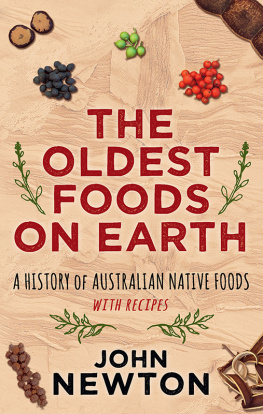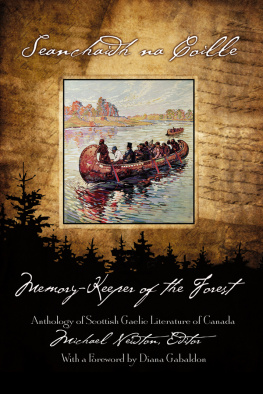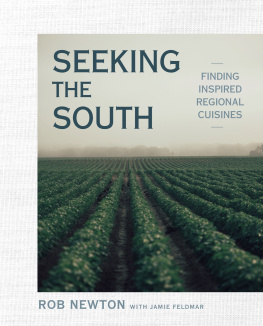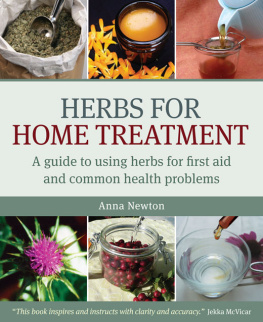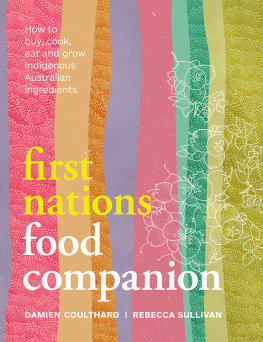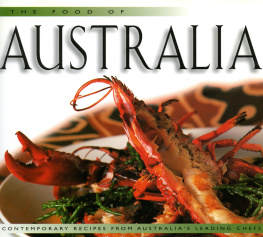THE OLDEST FOODS ON EARTH
J OHN N EWTON is a freelance writer, journalist and novelist. He writes on food, eating, travel, farming and associated environmental issues. His most recent books are Grazing: The Ramblings and Recipes of a Man Who Gets Paid to Eat (2010) and A Savage History: Whaling in the Pacific and Southern Oceans (2013). In 2005 he won the Gold Ladle for Best Food Journalist in the World Food Media Awards.
THE OLDEST FOODS ON EARTH
A HISTORY OF AUSTRALIAN NATIVE FOODS WITH RECIPES
JOHN NEWTON

A NewSouth book
Published by
NewSouth Publishing
University of New South Wales Press Ltd
University of New South Wales
Sydney NSW 2052
AUSTRALIA
newsouthpublishing.com
John Newton 2016
First published 2016
This book is copyright. Apart from any fair dealing for the purpose of private study, research, criticism or review, as permitted under the Copyright Act, no part of this book may be reproduced by any process without written permission. Inquiries should be addressed to the publisher.
National Library of Australia
Cataloguing-in-Publication entry
Creator: Newton John, author.
Title: The Oldest Foods on Earth: A history of Australian native foods, with
recipes / John Newton.
ISBN: 9781742234373 (paperback)
9781742242262 (ebook)
9781742247632 (ePDF)
Notes: Includes index.
Subjects: Natural foods Australia History.
Wild plants, Edible Australia History.
Cooking, Australian.
Cooking (Natural foods) Australia.
Dewey Number: 641.302
Design Josephine Pajor-Markus
Cover design Blue Cork
Cover images Oliver Strewe/Corbis
All reasonable efforts were taken to obtain permission to use copyright material reproduced in this book, but in some cases copyright could not be traced. The author welcomes information in this regard.

CONTENTS
INTRODUCTION
When was the last time you seared a kangaroo fillet and served it with a pepperberry sauce? Have you ever eaten quandong? Riberries? Magpie goose? Did you know that before we arrived in 1788 the Aboriginal people of the tropical North chose from among 750 different plant and animal foods? Did you know that Australian native rices (Oryza rufipogon and O. meridionalis) were an abundant and widespread resource in floodplains across monsoonal Australia and were harvested and consumed by the First People for thousands of years? Only now are they being cultivated for wider consumption.
This is a book about Australian food. Not the food that European Australians cooked from ingredients they brought with them, but the unique flora and fauna that nourished the Aboriginal peoples of this land for over 50 000 years. Indeed, it is because European Australians have hardly ever touched these foods for over 200 years that I am writing this book. The reason we virtually ignored the foods that were here when we came is part of this story. But only a part. The real story is that these foods are, finally, beginning to be used by home and professional chefs. Its somewhat tentative especially in the home but its a start. Theres a long way to go yet.
The first time I ate kangaroo was in 1993 at a long-gone restaurant called Oasis Seros. I was reviewing the restaurant for The Sydney Morning Herald Good Food Guide. The chef was Phillip Searle and the dish was Kangaroo with Pickled Beetroot. I have never forgotten it. The combination of the lightly seared roo with the complex acidity of the sauce was, for this diner, unforgettable. For this book, I made contact with Phillip, and he very kindly gave me the recipe, which youll find at the end of this introduction (see page xvii).
In more than 200 years of occupation of this continent, European Australians have turned their backs on the vast majority of the foods the Indigenous people have been eating for more than 50 000 years; ignored their sage and intricate management of the environment and its abundant foods; overlaid an alien system of agriculture which began the process of ecological imbalance the continent now finds itself in; and began exporting back to Europe the exotic foodstuffs they planted and raised. And, for around 150 years, stuck stubbornly to the diet of the first settlers.
In short, we lived on and not in this continent. We did not put down roots and did not see, as American food historian Waverley Root asserted, that food is a function of the soil, for which reason every country has the food naturally fit for it. Every country, that is, except Australia.
As I was writing this I flicked across to the Sydney Morning Herald website. There was a clickbait headline: Where to taste the worlds best cuisines. Alright, Ill bite, tell me: Japan, Peru, France, Spain, Morocco, Argentina, Taiwan and Italy. There appears to be something missing. And its not the cultural cringe, though were good at that.
Later Ill discuss those foods breathlessly referred to as superfoods in the health pages of our glossies. Why do they always come from somewhere else, some usually exotic place? The acai berry from Amazonia; the goji berry from the Ningxia Hui region in north central China or the Xinjiang Uighur region in far northern China; quinoa from Peru and Bolivia. If those imports are superfoods, the foods that have been growing here for thousands of years, Australian native foods, foods that weve virtually ignored for the 200-plus years weve been here, are super-duperfoods.
In this book, I deal with what pioneer native foods chef Jean-Paul Bruneteau calls food racism, the kind that has, in the past, played its part in the rejection of these foods because they were Aboriginal foods. It is only one of the many kinds of racism directed against the Aboriginal people, even today. My own belief is that non-Indigenous Australians must accept that the original inhabitants have carefully stewarded this land for the entire time they have lived here, and have the oldest unbroken culture in the world, before that racism culinary and otherwise will disappear.
And theres something else really puzzling about our rejecting and ignoring the foods that grow here. Australia has absorbed, with minimal racial problems, more nationalities than just about any country on earth. And as the philosopher and historian Anthony Corones has shown, Australia is not just a multicultural society, but a multiculinary one. As pioneer native Australian food restaurateur Jennice Kersh once said, We have embraced multicultural food more than any country in the world. Australia jumped in there and hugged it all. Theyd go to a Thai restaurant any kind of restaurant and have no fear. Well happily eat boat noodle soup with beef blood stirred through it or stinking tofu, but not kangaroo. Which dispenses with the theory of neophobia fear of the new: in this instance, new food.
Theres something else going on here in the rejection of native foods. Moving on from that rejection can only be good for Australian culture.
A study carried out in Malaysia concludes by noting that When two or more ethnic groups share foodways, they become closer. The report also suggests that when different ethnic groups share food, it strengthens social bonding and alliances among communities and ethnic groups an important consideration in multiculinary and multicultural Malaysia, a country often riven by racial and ethnic conflict.
I do believe that Australian multiculinarity accepting the food of the others, eating our neighbours food has helped us ease our way into what is generally a remarkable multicultural stability.
Next page
